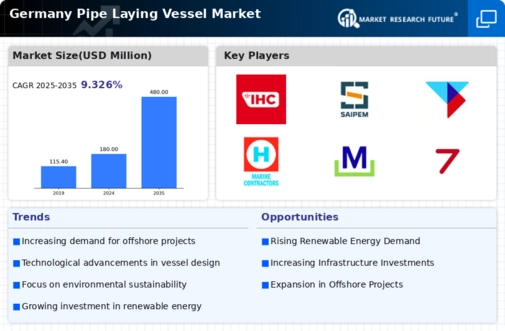Growing Demand for Renewable Energy
The increasing focus on renewable energy sources in Germany is driving the pipe laying-vessel market. As the country aims to transition to greener energy, significant investments are being made in offshore wind farms and other renewable projects. This shift necessitates the deployment of advanced pipe laying vessels to install subsea cables and pipelines efficiently. The German government has set ambitious targets, aiming for 65% of its energy to come from renewable sources by 2030. This transition is expected to create a robust demand for specialized vessels, thereby enhancing the pipe laying-vessel market. Furthermore, the market is projected to grow at a CAGR of approximately 4.5% over the next five years, indicating a strong upward trajectory driven by renewable energy initiatives.
Regulatory Framework and Compliance
Germany's stringent regulatory environment plays a crucial role in shaping the pipe laying-vessel market. The government has established comprehensive regulations to ensure environmental protection and safety standards in marine operations. Compliance with these regulations often requires the use of advanced technology and specialized vessels, which can lead to increased operational costs. However, this regulatory framework also encourages innovation and the development of more efficient vessels. Companies that invest in compliance and technology are likely to gain a competitive edge in the market. The emphasis on adhering to regulations is expected to drive the demand for modern pipe laying vessels, as operators seek to meet the evolving standards set forth by the German authorities.
Expansion of Offshore Infrastructure
The expansion of offshore infrastructure in Germany is a significant driver for the pipe laying-vessel market. With the increasing need for energy security and the development of new offshore projects, there is a growing requirement for efficient and capable vessels. The German government has committed to enhancing its offshore infrastructure, including pipelines for natural gas and renewable energy. This commitment is reflected in the allocation of approximately €10 billion for infrastructure projects over the next decade. As these projects progress, the demand for specialized pipe laying vessels is expected to rise, providing opportunities for market players to capitalize on this growth.
Technological Innovations in Vessel Design
Technological innovations in vessel design are transforming the pipe laying-vessel market. Advances in automation, digitalization, and vessel efficiency are enabling operators to enhance productivity and reduce operational costs. The introduction of dynamic positioning systems and advanced monitoring technologies allows for more precise and efficient pipe laying operations. As the industry evolves, companies that adopt these innovations are likely to improve their competitive positioning. The German market is witnessing a trend towards the integration of cutting-edge technologies in vessel design, which is expected to drive demand for modern pipe laying vessels. This trend may lead to a market growth rate of around 5% annually as operators seek to leverage these advancements.
Increased Collaboration Between Public and Private Sectors
Increased collaboration between public and private sectors is emerging as a key driver in the pipe laying-vessel market. The German government is actively engaging with private companies to facilitate infrastructure development and enhance operational efficiency. This partnership approach is fostering innovation and investment in the sector, leading to the development of new projects and technologies. Public-private partnerships are expected to play a vital role in financing and executing large-scale infrastructure initiatives, thereby boosting the demand for pipe laying vessels. As these collaborations strengthen, the market is likely to experience accelerated growth, with projections indicating a potential increase in market size by 6% over the next few years.




















Leave a Comment